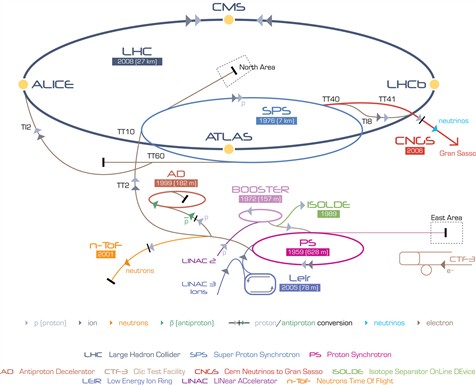| |

Nearly 20 years of hard work by hundreds of people have made this machine a dream come true. Today, the LHC has delivered its first high-energy collisions to the experiments. The new data will give us an unprecedented tool to understand the Universe we live in.
>>
|

At a meeting of the CERN Council a couple of weeks ago, one delegate stood up and reminded us that the LHC is not a turnkey machine. The great achievement of today is that those responsible for its construction and operation are making it look as if it is.
>>
|

Particles are supplied to the LHC by six accelerators inter-connected by several kilometres of transfer lines. This represents yet another complex chain of processes whereby particles are produced, bunched, synchronised and injected into the LHC at the precise moment it's ready to receive them. In other words, for collisions to be produced at the end of the chain, all the injectors must be in perfect working order.
>>
|
What makes the LHC the biggest particle accelerator in the world? Here are some of the numbers that characterise the LHC, and their equivalents in terms that are easier for us to imagine.
>>
|
From quarks to yet unknown particles, CERN continues to explore new frontiers in physics. Thanks to some of the most complex instruments ever made in a laboratory, Nature can reveal its inner secrets to the scientists.
>>
|
As the LHC goes on line for its first exploration of the new high-energy frontier, CERN is also getting ready to enhance the support it provides for the analysis and interpretation of the emerging data.
>>
|
How much does the LHC cost? And how much does this represent in other currencies? Below we present a table showing some comparisons with the cost of other projects. Looking at the figures, you will see that the cost of the LHC can be likened to that of three skyscrapers, or two seasons of Formula 1 racing! One year's budget of a single large F1 team is comparable to the entire materials cost of the ATLAS or CMS experiments.
>>
|
The idea of the Large Hadron Collider (LHC) was born in the early 1980s. Although LEP (CERN’s previous large accelerator) was still under construction at that time, scientists were already starting to think about re-using the 27-kilometre ring for an even more powerful machine. Turning this ambitious scientific plan into reality proved to be an immensely complex task. Civil engineering work, state-of-the-art technologies, a new approach to data storage and analysis: many people worked hard for many years to accomplish all this.
>>
|
On Thursday 25 March 2010, at the second part of the Induction Programme, members of CERN Management welcomed recently-recruited staff members and fellows.
>>
|
|
|
|
|